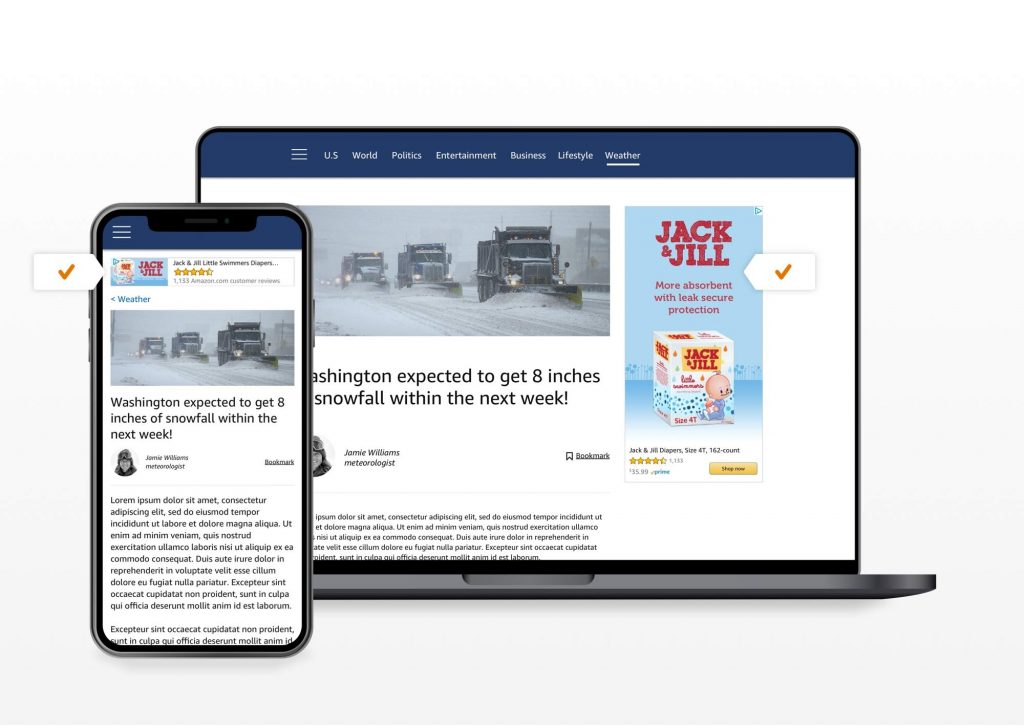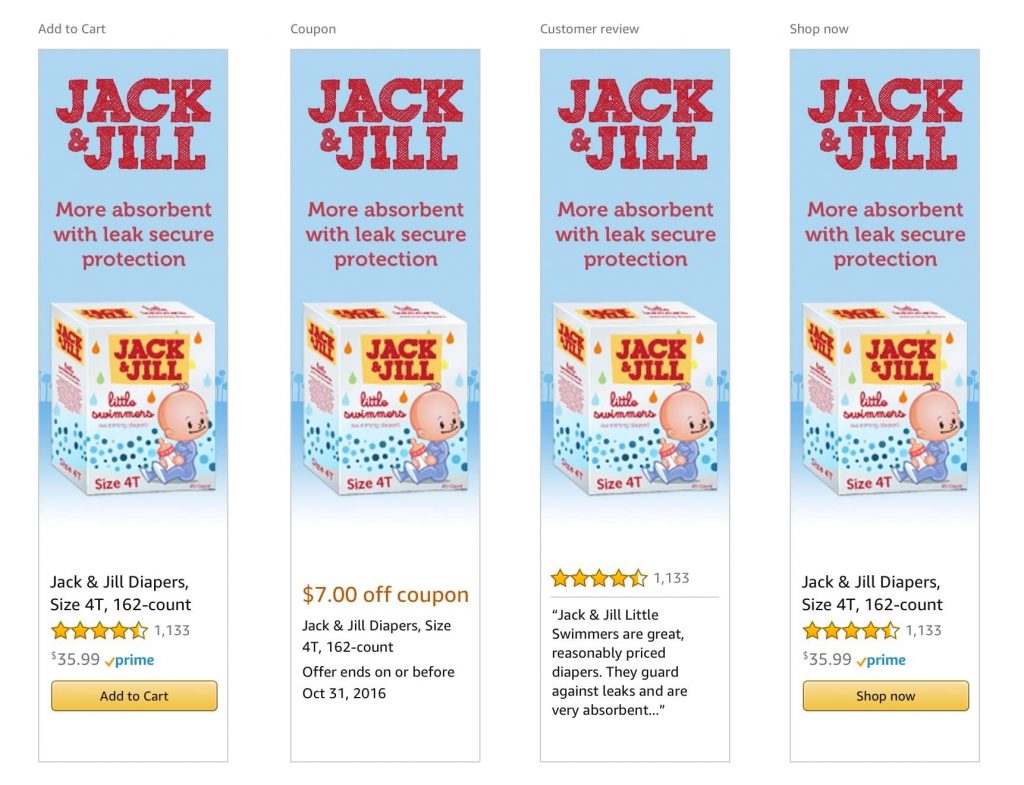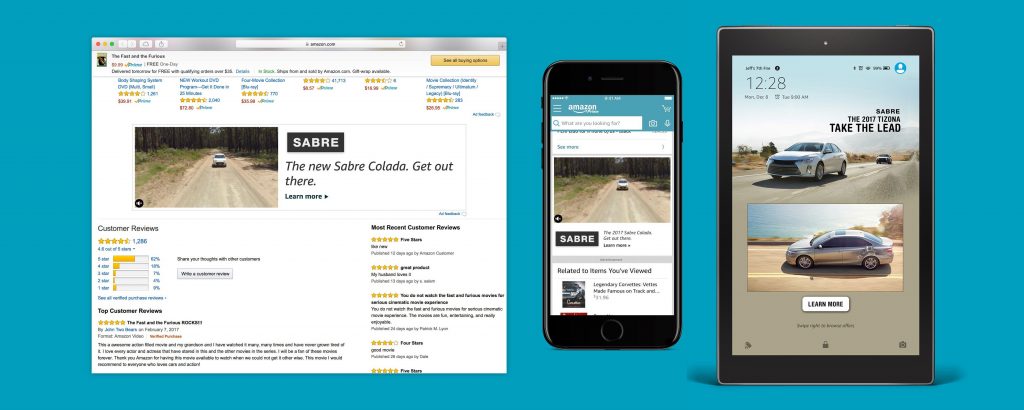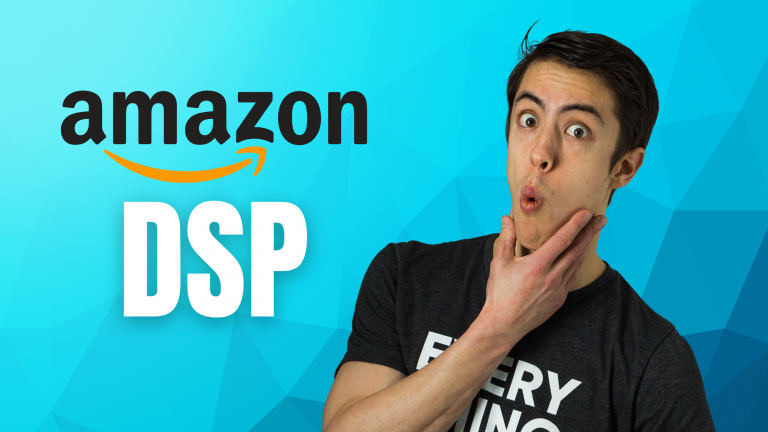Last updated on April 5th, 2021 at 11:34 am
For sellers looking to get on that next level of advertising on Amazon, look no further than Amazon Demand Side Platform (DSP).
Amazon DSP provides the opportunity to brands looking for a way to further develop their advertising strategy through advanced targeting and precise audience control.
It’s a great way to not only increase brand awareness on Amazon, but off Amazon as well.
So whether this is your first time hearing about Amazon DSP, or you’re looking for ideas to get started, we’ve got you covered.
What is Amazon DSP?
Amazon DSP is a platform for programmatically purchasing video and display ads across the entire internet.
What’s a display ad? Here’s an example:

You’ve probably seen hundreds of them all around the web without even realizing they’re from Amazon!
What do I mean by “programmatically”? It’s just a fancy word that means Amazon’s algorithm automatically selects and bids on the best ad spaces (on and off Amazon) based on your budget, base/max bid, and target audience.
And the best part about it is that because Amazon’s algorithm is constantly getting new customer data, its targeting capabilities only get better each day.
Where Will Amazon Display Ads & Videos Be Shown?
Amazon Display and Video Ads may appear on:
- Amazon O&O (owned and operated) sites, apps, and devices: Zappos, Goodreads, Twitch, ShopBop, Audible, etc.
- Amazon devices: Amazon Echo, Amazon Kindle, Amazon Fire tablet, Amazon Fire TV, etc.
- Third parties, a.k.a., the whole internet
Now that’s a huge number of people you have access to with Amazon DSP!
How Do Amazon DSP Ads Work?
You might be thinking, “What makes these ads different from Google or Facebook ads?”
What makes Amazon DSP ads stand out is one thing: consumer data.
You see, Google is good at knowing what you search for. Facebook is good at knowing what you like. But Amazon is good at knowing what you buy.
Why is Amazon So Good at It?
Amazon was an early adopter of Big Data back in 2003. Since then, they’ve basically made it a business of knowing the who, what, when, why (or why not) and at what price of ecommerce.
Chances are they know more about your shopping behaviours better than you know it yourself. They have enough data to basically predict as well as influence shopping behaviour.
How Does Amazon Collect This Customer Data?
Essentially, what they do is track behaviour such as which websites you visit (or specific pages) and what actions you perform on these websites. This is called Pixel Based targeting and you may be familiar with it through Facebook ads.
What Amazon’s algorithms then do is they group certain activities and data points into sets. These sets are groups of people whose behaviour can be predictable based on the behaviour of other members of that set. This is called Audience Lookalike.
For example, let’s say Tim and Steve are both into vegan health supplements and premium yoga mats. If Tim expresses an interest in reusable bamboo cups, then chances are high that Steve will also be into this.
How & What Does Amazon DSP Target?
Amazon harnesses all this data to target in six different ways:
- Behavioural: hones in on customers who have shown specific behaviours such as buying or browsing specific product categories over the past 30 days.
- Contextual: shows real-time ads to people as they browse the web based on websites they’ve been to that are thematically similar to your product.
- Lifestyle: shows ads relevant to people who habitually buy from a certain category (such as Exercise & Fitness), suggesting a certain lifestyle.
- Remarketing: re-engages customers who have previously interacted with your product or brand.
- Audience Lookalike: targets customers who behave similarly to selected groups, such as a certain brand’s customers or a competitor’s customers.
- Advertiser Audience: leverages information from a brand’s data, such as CRM data, a hashed email list, or a product page with a tracking pixel.
With all these different targeting types and Amazon’s massive well of data, you’re bound to find a treasure trove of customers waiting to buy your product.
Is Amazon DSP Worth Your Time & Money?
Now you might be thinking, holy cow, with all that data I can create such a powerful ad campaign! Sign me up!
Hold up. It’s not quite that easy.
Unlike a lot of other Amazon features, Amazon DSP isn’t as simple as just signing up. You’ll need to choose between two options: Amazon Managed Service or Enterprise Self-Service.
Amazon Managed Service
By choosing this option, you’re employing Amazon’s ad team to manage your campaigns.
To make this worthwhile, there is a minimum ad spend of $35,000 USD.
This option is best suited for brands without much knowledge of DSP and/or brands who want almost everything done for them.
Enterprise Self-Service
This is the “self-serve” option. By going at yourself, you avoid Amazon’s minimum ad spend restrictions plus have a greater degree of control over your campaigns.
While there is no minimum ad spend, Amazon does recommend that you have a budget of $10,000 USD per month for a period of no less than three months to get any benefit out of this program.
Also, brands may only have access to the portal through an approved agency. Which means you won’t actually be able to do it 100% yourself.
These providers usually charge 7-25% of the clearing price. The actual cost will depend on the provider you select, your budget, and the complexity of the campaigns you’ll be running.
This option is best suited for experienced brands who know what they want, how they want to get it, and who enjoy having greater control over their campaigns.
Is It Worth It?
The bottom line is: it depends.
The best way to think about Amazon DSP is that “next-step” for your Amazon brand, product or service.
Regardless of which option you choose, individual ads will be charged based on CPM (cost per 1000 impressions). This is unlike PPC, which only charges you per click.
A brand-new seller isn’t likely to benefit from Amazon DSP. In fact, it would probably be overkill and extremely cost-prohibitive. New sellers should stick to just using Amazon PPC.
But, if your brand is more established, you have more capital and you’re looking to scale up, Amazon DSP should definitely be your next move. It’s a terrific way to target people who aren’t looking for your product on Amazon, as well as retarget people who are likely to buy your product.
What’s the Difference Between Sponsored Product Ads & DSP Ads?
You might be wondering what the differences are between Amazon Sponsored Product ads (a.k.a. Amazon PPC) and DSP ads.
Here’s the rundown:
- Amazon PPC ads only show up on Amazon―DSP ads can appear on and off Amazon, on any Amazon-related device, and third party (non-Amazon) websites across the entire world wide web.
- Amazon PPC is available for Vendors and Sellers in eligible categories and who have the Buy Box―DSP is only available for users with a large marketing budget exceeding $35,000 who want to work with an Amazon advertising consulting, or who want to work with a qualified agency to access Enterprise Self-Service.
- Ad placements are charged per click for PPC―DSP ads are charged CPM (cost per 1000 impressions).
- PPC ads can target based on keyword, ASIN, category and brand―DSP ads can target based on Behavioural, Contextual, Lifestyle, Remarketing, Audience Lookalike, and Advertiser Audience.
One last thing: Amazon PPC and Amazon DSP serve two different marketing purposes.
Namely, that PPC is more for low-funnel marketing, whereas DSP is more for high-funnel marketing.
“Low-funnel” marketing means that you are marketing to people who are the closest to actually buying. Essentially, it’s like holding up a juicy steak to a lion who hasn’t eaten in 2 months.
Think about it this way: If Amazon was a physical store, PPC ads are like paying someone to put your products right at the front of the store so that your product is visible for customers looking to buy it.
By contrast, Amazon DSP ads are like the marketing that takes place outside of the store. These efforts are more “high-funnel” because they don’t directly lead to a sale―rather, its purpose is to generate brand awareness and interest amongst your target audience.
Types of Amazon DSP Ads
Now that you understand how Amazon DSP works, let’s dive into the various types of DSP ads you can run.
Here are the four main types of ads you can run for your brand through DSP:
Dynamic Ecommerce
Dynamic ecommerce ads automatically optimize which creative shows based on your campaign goal.
What this means is that it adapts to whatever the algorithm thinks will get the individual to click on that ad.
For example:

- If a customer likes to read reviews before purchasing a product, they’ll serve an ad with a review included.
- If a customer is more of an impulse buyer, they’ll serve an ad with an “add to cart” button and a coupon.
- etc.
Dynamic ads only link to the product detail page on Amazon.
Static Ads
Static ads don’t have any dynamic elements, so you’ll need to add specific calls-to-action, such as “Shop Now”.
I’d recommend these ads to target people in the mid to upper-funnel of the buyer’s journey to draw buyers in and grow brand awareness.
These ads lead to an Amazon storefront, product detail page, or custom landing page.
Video Ads
Video ads are a great way to tell your brand story, connect emotionally with your audience, and communicate a large amount of information quickly. Video ads through DSP can run within video content or as part of a display ad.

You can link your video ads through DSP to a product detail page on Amazon or to your website. Running video ads through DSP means you can leverage Amazon’s massive database of consumer purchasing behaviour to ensure your videos get in front of the right audience.
Over-the-Top Video Ads
Similar to above, but these are non-skippable, full-screen ads that reach people connected to TV sources like the Amazon Fire TV Stick.
You can target specific audiences, but note that these types of ads are not clickable. As such, they are perfect for targeting high-funnel audiences.
Amazon DSP Ads Strategy
Ready to make your first Amazon DSP ad? Great! Let’s start by defining the goal (or goals) of your campaign.
There are three main goals of Amazon DSP ads:
Goal #1: Retargeting
Retargeting means showing your product or brand to someone who has already demonstrated an interest in purchasing your product.
Retargeting ads are monstrously effective. According to statistics, retargeted audiences are 43% more likely to convert. So you’re essentially going after the low-hanging fruit with this strategy.
Goal #2: Brand Awareness
Retargeting is great for people who already know you―but what about people who don’t?
Amazon DSP ads are also great for reaching out to new prospects who don’t know they need your product yet.
So while retargeting is honing in on people on the low end of the funnel, brand awareness is targeting people on the high end of the funnel.
Why is this important?
Because if you can reach out to people who are likely to convert in the future―before they even express an interest in your product―you’re helping them choose you over your competitors. They may not convert right away (or ever), but by playing the long-term game, you’re setting yourself up for success in the future.
Goal #3: Marketing Insights
With all this juicy data, DSP ads can tell you a lot about who your customers are. And knowing who they are will help you tailor your marketing strategy to them in the future.
For example, you might be surprised to learn that your ads perform well amongst women aged 40-50 who expressed an interest in yoga.
Or, that people who like your products also share other common interests, like hiking or cars.
You can also benefit from learning about how users shop your product, how often and when.
Ultimately, these data points help you position your brand and tailor your marketing strategies.
Conclusion
Amazon DSP is the go-to place for brands looking to utilize big data to take their marketing to the next level.
While PPC is great for targeting customers on the low end of the funnel, DSP is the perfect way for drawing customers in on the high end of the funnel. Utilizing both strategies makes for a powerful marketing strategy.
Not quite ready yet for Amazon DSP? Check out more information about Amazon PPC here.


